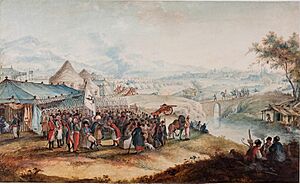Persian expedition of 1796 facts for kids
Quick facts for kids Russo-Persian War of 1796 |
|||||||||
|---|---|---|---|---|---|---|---|---|---|
| Part of Russo-Persian Wars | |||||||||
 Oath of allegiance of the Novoshemakhan Gasim khan to Russia among the corps under the command of Count V. A. Zubov off the Aksuchay River in 1796 by Gavriil Sergeev. A late 1790s painting. |
|||||||||
|
|||||||||
| Belligerents | |||||||||
| Commanders and leaders | |||||||||
| Strength | |||||||||
| 50,000 (other estimates suggest 30,000–40,000) | Tofangchi musketeers Royal regiment of Mohammad Khan Northern town watch |
||||||||
| Casualties and losses | |||||||||
| 2,150 men | Unknown | ||||||||
The Persian expedition of Catherine the Great in 1796 was a short war. It was part of the Russo-Persian Wars of the 1700s. This war did not change much for either side. It was similar to another expedition led by Peter the Great many years before.
Contents
Why the War Started
The late 1700s were a time of trouble in Persia. Many leaders fought to become the new Shah, or ruler. Empress Catherine the Great of Russia saw this as a chance to gain power. She wanted to control areas in the Caucasus region. This area was important to Persia.
Georgia Joins Russia
The kingdom of Georgia had been under Persian rule for a long time. In 1783, Georgia's King Erekle II signed a deal with Russia. This deal was called the Treaty of Georgievsk. It made Georgia a Russian protectorate. This meant Russia promised to protect Georgia from attacks, especially from Iran. Other local leaders also asked for Russia's protection.
A New Persian Shah
In 1794, Agha Mohammad Khan became the new Shah of Persia. He was a strong leader. He ended the fighting among Persian leaders. He wanted to make Persia powerful again. He focused on getting back control of the Caucasus. He sent soldiers to cities in modern-day Dagestan, Azerbaijan, and Armenia.
Persia Attacks Georgia
In 1795, Shah Agha Mohammad Khan attacked Georgia. He wanted to show that Persia was still in charge. His army destroyed Tbilisi, Georgia's capital. This attack made Empress Catherine angry. She decided to send an army to punish the Shah. Russia also hoped to replace the Shah with his half-brother, who was friendly to Russia.
Russia's Military Plan
Many people thought a skilled general would lead Russia's army. But Empress Catherine chose a young leader instead. She listened to her favorite, Prince Platon Zubov. He suggested his younger brother, Count Valerian Zubov, lead the army.
The March to Derbent
The Russian army had about 50,000 soldiers. They started their journey from Kizlyar in April 1796. Their first big goal was to capture the strong fortress of Derbent. They attacked and took Derbent on May 10. A famous Russian poet, Gavrila Derzhavin, wrote a poem celebrating this victory.

Taking Over Azerbaijan
By the middle of June, Zubov's army had moved quickly. They took control of most of modern-day Azerbaijan. They captured important cities like Baku, Shemakha, and Ganja. There was not much fighting in these areas. By November, the Russian troops were near the Araks and Kura Rivers. They were ready to move into mainland Iran.
The War Ends Suddenly
In November 1796, Empress Catherine of Russia died. Her son, Emperor Paul, became the new ruler. Emperor Paul did not like the Zubov family. He also had different plans for the army. He ordered the Russian troops to return home.
This sudden order made many officers angry. They had worked hard in the campaign. Some of these angry officers later joined a group that planned Paul's assassination. This happened five years after the war ended.
Sources
- Gen. V.A. Potto. The Caucasian Wars of Russia from the 16th century onward. Volumes 1–5. SPb, 1885–86, reprinted in 2006. ISBN: 5-9524-2107-5.

